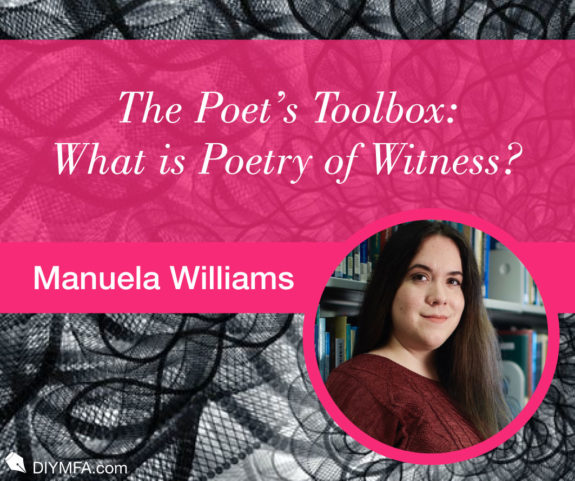Welcome back, poets! In my last post, I talked about confessional poetry—a brief history, defining characteristics, and a couple exercises to get you started writing some confessional poetry of your own. Today, I’d like to talk about poetry of witness, a mode that I’d argue is a close cousin of the confessional (with some key differences, of course).
First, I’ll give a brief definition of poetry of witness before moving on to some ideas that complicate this initial definition. Finally, I’ll leave you with some recommended reading so you can further explore this mode of poetry.
How is Poetry of Witness Defined?
The term “poetry of witness” was initially coined by poet Carolyn Forché in her 1993 introduction to Against Forgetting: Twentieth-Century Poetry of Witness.
Forché defines the poetry of witness as inhabiting the social sphere, a space between the personal and political (31). Forché’s anthology focuses on poets who witnessed, first-hand, events of extremity. This includes poets who “endured social conditions of historical and social extremity during the twentieth century—through exile, state censorship, political persecution, house arrest, torture, imprisonment, military occupation, warfare, and assassination” (29).
The Question of Extremity
Complicating the above definition of poetry of witness is the idea of extremity. In compiling the Against Forgetting anthology, Forché included poems from those who endured social and historical extremity—for example, war, torture, and imprisonment.
It is unclear, however, whether personal extremity fits into this definition of poetry of witness. Does survival after a more personal tragedy, such as the loss of a child or parent, allow a poem to be labeled as a poem of witness?
Forché writes that applying the “personal” label to poetry “call[s] to mind lyrics of love and emotional loss,” so it could be argued that poems and collections dealing with personal loss and grief, such as in Sharon Olds’ The Father, do not fit Forché’s “poetry of witness” definition, as such work is mainly preoccupied with the personal and, at least on the surface, does not occur within a space of political resistance and struggle (31).
Cathy Linh Che’s Split, however, might better fit Forché’s definition. Though Che’s collection borrows from the confessional mode and is rooted in the personal, the act of writing about sexual abuse could be seen as an act of resistance, especially when there can be a lot of shame and silence surrounding the abuse.
What about Proximity to Extremity?
Further complicating Forché’s definition of poetry of witness is the idea of proximity to extremity. Forché does not address how close a poet must be to extremity in order to classify their work as poetry of witness.
Many of the poets included in her anthology seem to have experienced conditions of extremity first-hand—for example, one included poet, Miklós Radnóti, worked in a forced-labor camp during the Holocaust and was eventually executed when the Germans evacuated the camp.
It’s unclear, however, if witnessing and writing about an event from more of a distance classifies a poem as a poem of witness.
Poet Patricia Smith, for example, did not directly experience Hurricane Katrina in New Orleans, but witnessed it through news reports and other documents, excerpts of which sometimes appear as epigraphs in her collection Blood Dazzler.
It could be argued that, despite Smith’s relative distance to the destruction caused by Hurricane Katrina, her poems in Blood Dazzler still occupy a space between the “personal” and the “political.” Many of the poems in the collection are “persona poems”, foregrounding the lyric “I” and individual experiences of the hurricane, but others gesture outward to encompass the political realm.
What’s Next?
It might be time to revisit Carolyn Forché’s initial 1993 definition of poetry of witness and consider the different ways in which events are witnessed.
For instance, news reports and images that document a war are, in some places, widely distributed and accessible, making it easier for individuals to “witness” an event from afar. Though news reports and images can certainly be altered or edited in some way, this is not always the case. As such, Forché’s definition could be expanded to include a second tier: not only does poetry of witness encompass first-hand accounts (for instance, a prisoner of war), but also a form of “secondary” witnessing by those who experience an event through news reports, images, interviews, or other documents.
Further, Forché’s initial definition seems to focus primarily on war and political extremity (issues that are reflected in her collection The Country Between Us), however, this definition could also be expanded to include other events of historical and social extremity, such as natural disasters and massacres.
Recommended Reading
Carolyn Forché’s The Country Between Us
Carolyn Forché’s 1981 poetry collection, The Country Between Us, serves as a document of Forché’s time as a human rights activist in El Salvador between 1978 and 1980, a period when civil war was beginning to break out in the country. Split into three sections, the volume bears witness to shocking acts of murder, torture, and violence, as well as poverty and starvation.
Patricia Smith’s Blood Dazzler
Patricia Smith’s Blood Dazzler depicts the devastation of Hurricane Katrina. Many of the poems in the collection are “persona poems,” meaning that Smith inhabits an “other” or “persona” who serves as the poem’s speaker. Most notably, Smith embodies Hurricane Katrina in the volume’s four opening poems, which track the progression and eventual landfall of the hurricane in Florida.
Even More Suggested Reading
- Against Forgetting: Twentieth-Century Poetry of Witness, edited by Carolyn Forché
- Poetry of Witness: The Tradition in English, edited by Carolyn Forché and Duncan Wu
- Unclaimed Experience: Trauma, Narrative, and History, by Cathy Caruth

Manuela Williams lives and writes in Nevada. She is the author of two poetry chapbooks and one paranormal fiction novella. When she’s not writing, Manuela loves reading romance novels, drinking *all* the coffee, and playing video games.







